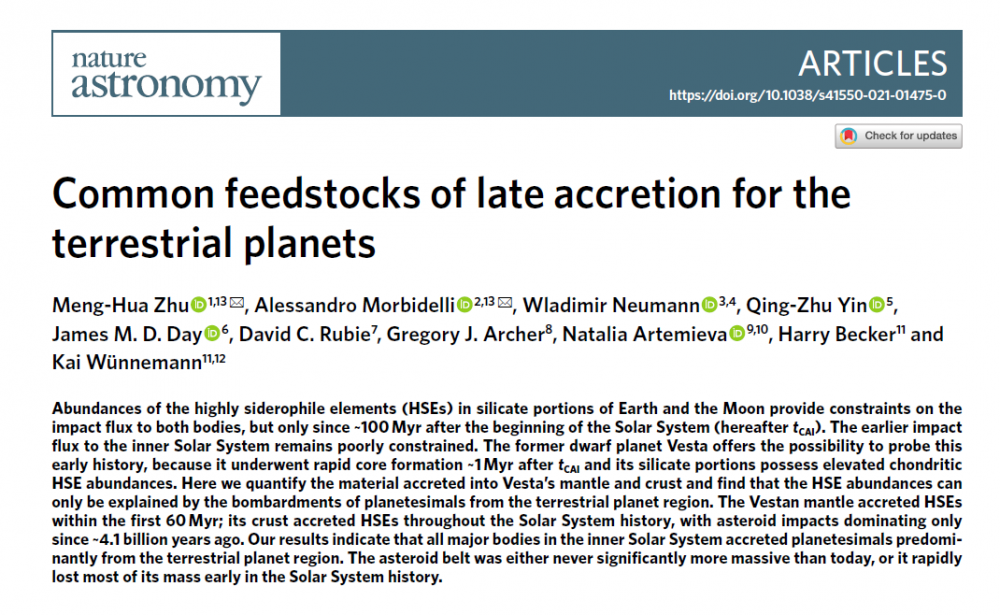Associate Professor Meng-Hua Zhu of Macau University of Science and Technology, a researcher at the State Key Laboratory of Lunar and Planetary Sciences of M.U.S.T., has recently published a research paper named “Common bombardments of Planets in the early Solar System” in Nature Astronomy. Dr. Zhu has a long-lasting relation with M.U.S.T. where he received his Ph.D. degree and took positions as a teaching and research faculty member. This research was supported by the FDCT.
Dr. Zhu's paper shows that the terrestrial planets in our inner Solar System experienced long-term bombardments after they formed. The craters and basins on the surface of the Moon recorded this bombardment, but obviously not before lunar formation, about 4.51 billion years ago. However, our Solar System started to form much earlier, about 4.567 billion years ago. What was the bombardment history before the formation of the Moon?
Vesta, a dwarf planet, provides a good opportunity to study the early bombardment history of the inner Solar System because it formed only in ~ 1 million years. Although Vesta’s craters may not fully record the impact history since Vesta’s formation time, the highly siderophile (iron-loving) elements can provide crucial information. When Vesta formed, its mantle and crust had almost zero of these iron-loving elements, as they were all in Vesta’s core. However, the objects bombarding Vesta progressively accumulated exogenous material in Vesta’s crust and mantle, changing the abundances of iron-loving elements. Therefore, the abundances of these elements measured in meteorites originating from Vesta can help scientists to reconstruct Vesta’s bombardment history.
|
|
|
|
Associate Professor Meng-Hua Zhu |
|
Dr. Meng-Hua Zhu lead an international team that included members from Macau University of Science and Technology, University of Nice Sophia-Antipolis, Heidelberg University, University of California at Davis, University of California San Diego, University of Bayreuth, University of Munster, and the Planetary Science Institute. The team worked together to study the early bombardment history of the Vesta. The results of the study were published in the Nature Astronomy journal.
“Through computer simulations of the bombardment history of Vesta we found that none of the previous models of the bombardment history of Vesta explains its iron-loving element abundance. Instead, the bombardments produced by planetesimals originally from the terrestrial planet region, whose flux is calibrated on the lunar impact record, reproduces the masses of the materials implanted by the bombardment in Vesta’s mantle and crust, that are deduced from the abundance of iron-loving elements” explains Dr. Meng-Hua Zhu, a planetary scientist from the State Key Laboratory of Lunar and Planetary Sciences from Macau University of Science and Technology, China.
This result challenges the expectation that the collisional evolution in the asteroid belt, as witnessed by Vesta, is dominated by asteroid-asteroid collisions. “Our result indicates that both Vesta and the terrestrial planets have been bombarded predominantly by planetesimals originating in the terrestrial planet region. This result provides strong evidences that the mass distribution in the inner Solar System was concentrated in an annulus in the terrestrial planet region. This is required in modern planet formation models to explain the small mass of Mars and challenges the classical view of a smooth protoplanetary disk” adds team member Dr. Alessandro Morbidelli, an astrophysicist from University of Nice–Sophia Antipolis, Nice, France.
The State Key Laboratory of Lunar and Planetary Sciences (M.U.S.T.) research subjects mainly involve planetary physics, planetary geology, and planetary chemistry. Since its inception it has been promoting technological and scientific innovations and making significant contributions to the academia.
To view the full research paper, please visit the online link from “Nature Astronomy”



